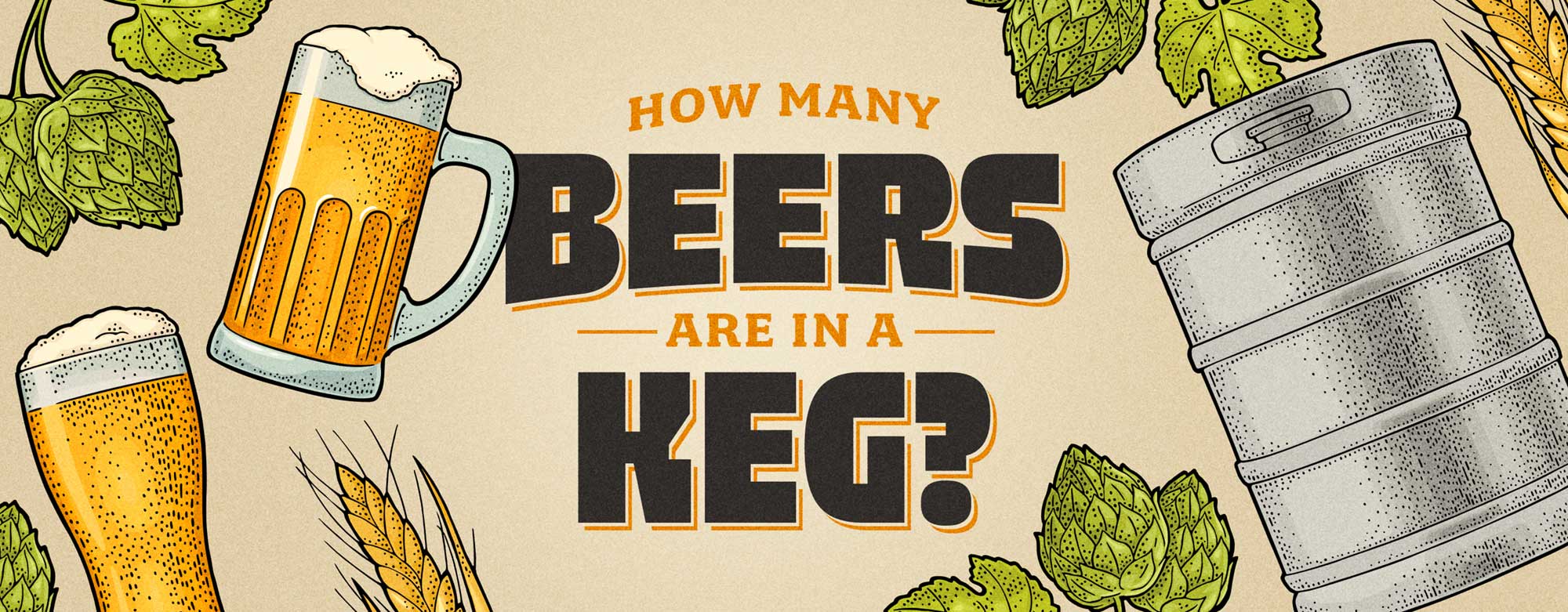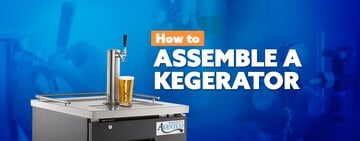
Whether you are starting a bar, running a catering business, or are a private chef planning a dinner party, kegs are a practical choice for serving drinks to a group of people. They play a vital role in commercial beverage service by enabling you to dispense large beer volumes without purchasing individual bottles or cans. With various keg sizes available, it can be challenging to determine which size is best suited for your needs. We explore the capacities of commercial kegs to help you make an informed decision.
How Many Drinks Are In a Keg?
Watch the video below for a walkthrough of how many beers are in each type of keg!
How Many Beers per Keg
How many beers per keg depends on the keg size! Below, walk you through the capacity of different types of kegs so you know which size to order for your event.
How Many Beers in a Half Barrel Keg?

A half barrel keg, also known as a full-size keg or full keg, can hold approximately (165) 12-ounce cans or bottles of beer. In terms of pints, a half barrel keg is equivalent to 124 pints. Its substantial 15.5-gallon capacity makes it a convenient and cost-effective option for beer gardens, sports bars, and other commercial establishments serving a high volume of beer.
- What Is the Capacity of a Half Barrel Keg? 15.5 gallons
- How Many Pints Are in a Half Barrel Keg? 124 pints
- How Many Bottles Are in a Half Barrel Keg? 165 bottles
How Many Beers in a Quarter Barrel Keg?
 A quarter barrel keg holds approximately 7.75 gallons of beer, which is equivalent to 62 pints or (82) 12-ounce bottles or cans of beer. This keg size is also known as a pony keg or stubby quarter keg. It's a popular choice for caterers serving alcohol at events. The compact size of the quarter barrel keg helps businesses offer a variety of beers without committing to a larger keg size.
A quarter barrel keg holds approximately 7.75 gallons of beer, which is equivalent to 62 pints or (82) 12-ounce bottles or cans of beer. This keg size is also known as a pony keg or stubby quarter keg. It's a popular choice for caterers serving alcohol at events. The compact size of the quarter barrel keg helps businesses offer a variety of beers without committing to a larger keg size.
- What Is the Capacity of a Quarter Barrel Keg? 7.75 gallons
- How Many Pints Are in a Quarter Barrel Keg? 62 pints
- How Many Bottles Are in a Quarter Barrel Keg? 82 bottles
How Many Beers in a Slim Quarter Keg?
 A slim quarter keg has a capacity of 7.75 gallons, approximately 62 pints of beer. It's a smaller footprint version of a standard quarter keg that holds the same volume of beer. For those who prefer to serve beer in bottles or cans, this keg can hold around (82) 12-ounce bottles or cans. One of the main advantages of a slim quarter keg is its ability to fit into smaller refrigerators or kegerators. It's the perfect option for businesses offering a variety of beers.
A slim quarter keg has a capacity of 7.75 gallons, approximately 62 pints of beer. It's a smaller footprint version of a standard quarter keg that holds the same volume of beer. For those who prefer to serve beer in bottles or cans, this keg can hold around (82) 12-ounce bottles or cans. One of the main advantages of a slim quarter keg is its ability to fit into smaller refrigerators or kegerators. It's the perfect option for businesses offering a variety of beers.
- What Is the Capacity of a Slim Quarter Keg? 7.75 gallons
- How Many Pints Are in a Slim Quarter Barrel Keg? 62 pints
- How Many Bottles Are in a Quarter Barrel Keg? 82 bottles
How Many Beers in a Sixth Barrel Keg?
 A sixth barrel keg typically holds 5.2 gallons of beer, which is equivalent to 41 pints or approximately (55) 12-ounce bottles. Also referred to as a sixtel keg or log keg, a barrel keg is a popular choice for microbreweries wanting to offer an expanded beer menu without taking up too much space. With its small footprint, the sixth barrel keg can easily fit into various types of kegerators.
A sixth barrel keg typically holds 5.2 gallons of beer, which is equivalent to 41 pints or approximately (55) 12-ounce bottles. Also referred to as a sixtel keg or log keg, a barrel keg is a popular choice for microbreweries wanting to offer an expanded beer menu without taking up too much space. With its small footprint, the sixth barrel keg can easily fit into various types of kegerators.
- What Is the Capacity of a Sixth Barrel Keg? 5.2 gallons
- How Many Pints Are in a Sixth Barrel Keg? 41 pints
- How Many Bottles Are in a Sixth Barrel Keg? 55 bottles
How Many Beers in a Cornelius Keg?
 The Cornelius keg typically holds five gallons of beer, which is equivalent to 40 pints or about (53) 12-ounce bottles. Also known as a homebrew keg, it is a popular choice for homebrewers and smaller commercial operations due to its convenient size and versatility. The Cornelius keg was originally used by the soft drink industry but quickly gained popularity in the brewing industry for its practicality and ease of use. It is perfect for brewing smaller quantities of seasonal fall beers.
The Cornelius keg typically holds five gallons of beer, which is equivalent to 40 pints or about (53) 12-ounce bottles. Also known as a homebrew keg, it is a popular choice for homebrewers and smaller commercial operations due to its convenient size and versatility. The Cornelius keg was originally used by the soft drink industry but quickly gained popularity in the brewing industry for its practicality and ease of use. It is perfect for brewing smaller quantities of seasonal fall beers.
- What Is the Capacity of a Cornelius Keg? 5 gallons
- How Many Pints Are in a Cornelius Keg? 40 pints
- How Many Bottles Are in a Cornelius Keg? 53 bottles
How Many Beers in a Mini Keg?
 Mini kegs are the smallest commercial keg available, typically holding 1.32 gallons of beer. To put this into perspective, a mini keg can fill approximately 10 pints or (14) 12-ounce beer bottles. One of the key advantages of mini kegs is their portability. Thanks to their compact size and lightweight construction, they are easy to transport and perfect for small gatherings like self-catered micro-weddings.
Mini kegs are the smallest commercial keg available, typically holding 1.32 gallons of beer. To put this into perspective, a mini keg can fill approximately 10 pints or (14) 12-ounce beer bottles. One of the key advantages of mini kegs is their portability. Thanks to their compact size and lightweight construction, they are easy to transport and perfect for small gatherings like self-catered micro-weddings.
- What Is the Capacity of a Mini Keg? 1.32 gallons
- How Many Pints Are in a Mini Keg? 10 pints
- How Many Bottles Are in a Mini Keg? 14 bottles
Keg Capacity Chart
Quickly find the capacity of different keg sizes. We explain how many gallons, pints, and 12-ounce beer bottles each keg equates to in our scannable chart.
Beer Keg FAQ

We answer some of the most common questions about beer kegs and their capacities below.
What Is a Keg?
A keg is a container designed to hold and serve large quantities of beer, hard cider, and other alcoholic or carbonated drinks. These containers are typically cylindrical and come in various sizes. Most kegs are pressurized, preventing carbon dioxide leakage and keeping their contents carbonated. Due to their capacity and portability, kegs lend themselves to a wide range of settings including local bars, wedding receptions, and music festivals.
How Long Does a Keg Last?
Pasteurized draft beer, heated to kill off bacteria or yeast, will generally last 3 to 4 months in a keg. Unpasteurized draft beer, which retains its live yeast, typically lasts 6 to 8 weeks. Proper storage is the key to making your beer last as long as possible. Kegs should be kept refrigerated at all times to maintain the quality of the beer inside. Warm temperatures can speed up the aging process and cause the beer to become flat and stale.
It's important to note that the countdown for a keg's shelf life begins when it is first filled at the brewery, not when you purchase it. When serving draft beer at a party or event, check the keg's packaging and verify when it was filled.
What Are Beer Kegs Made Of?
The two most common keg materials are stainless steel and aluminum. Learn about both types and what sets them apart:
- Stainless steel beer kegs: Stainless steel kegs are known for their durability. They feature excellent insulating properties, allowing you to keep beer cold for long periods.
- Aluminum beer kegs: One of the main advantages of aluminum kegs is that they preserve the taste of the beer better than other materials. These kegs are also lighter than their stainless steel counterparts, making them easier to transport.
Back to Top
Kegs are a valuable tool for any establishment that serves alcoholic beverages, and choosing the right one is essential. Ensure you always have enough of your signature beverages to satisfy customers by selecting the proper-sized beer keg.






